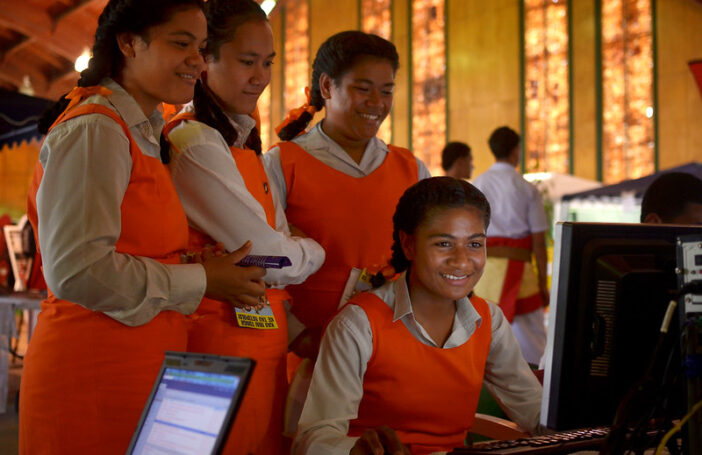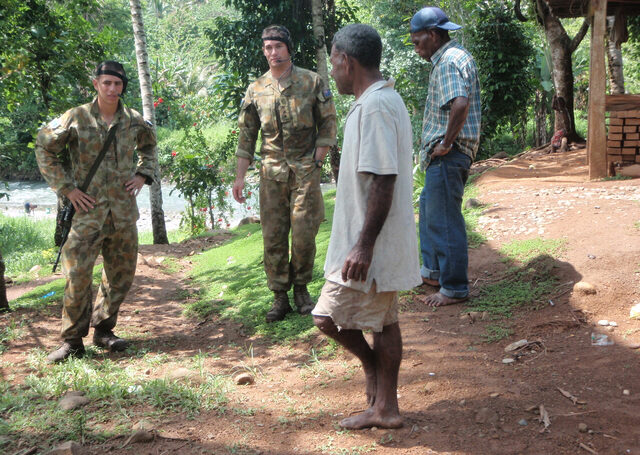On September 6th the Development Policy Centre hosted the 2012 Pacific Update at the ANU. The program consisted of panel discussions on PNG and Timor-Leste; Vanuatu, Tonga and Samoa; and Solomon Islands and Fiji. This post is a summary of the comments on the Solomon Islands’ economy made by Rick Hou, the Minister of Finance of the Solomon Islands. A video of the presentation is available here.
My presentation will focus on our economy: the recent story, its medium term outlook and the various actions (both policy and administrative) that the Government has or is taking.
A word of caution: the figures I quote are for a period of less than five years – too short for any long term forecast. Also, that period is immediately after a time of ethnic tension in Solomon Islands when the economic situation was at its worst, so while the numbers show large movements, they reflect the way in which the economy was playing catch up.
The Economy
With growth rates averaging over 8 percent in the past few years (2011: 10.5 percent), the Solomon Islands economy has shown a remarkable recovery from the global financial crisis.
The main driver for this growth is our export sector: increased volumes and values for primary production in forestry (mainly logging); minerals (the commencement of production by Gold Ridge mine in early-2011) and in agriculture (cocoa, palm oil and copra). Export growth has been driven by favourable international prices for these commodities.
Inflation rose to over 10 percent at the end of last year following some years of very low inflation (below 2 percent) previously. The 3 month moving average to mid-2012 indicated inflation has decelerated to below 6 percent.
Balance of Payments
On the external front, the balance of payments had also shown strong trends. In the first half of 2012, we posted a trade surplus of $100m, despite recording a trade deficit in the second quarter. This is attributed mostly to imports related to the Festival of Pacific Arts during the quarter.
The exports sector continues to dominate economic activity: in the first half of 2012 total exports rose by 31 percent while imports rose by 19 percent.
While logging (in value terms) still accounts for the majority of our total exports, its share of total exports has fallen to 45 percent and the share held by minerals has increased to 29 percent. This is consistent with the fact that there has been no new logging activity since last year, but there have been significant increases in other sectors, especially mining and agriculture.
External reserves continue to grow to current levels ($3.6 billion in mid-August 2012), which are equivalent to almost 10 months of import cover. The major sources of reserves growth are donors and trade receipts. The Central Bank of Solomon Islands (CBSI) estimate this position will be held across the second half of the year.
The Medium Term Forecast
The outlook for 2012 and for the next few years is that GDP will fall below the 2011 growth level. Revised numbers by CBSI indicate that growth this year will be around 4-5 percent.
As noted earlier, logging is not expected to contribute any new activity. Fishing and agricultural production will likely decline in response to a fall in international commodity prices.
The resumption of Gold Ridge mine will be an important and timely contribution to GDP. The company is expected to increase its production over the coming years. This will contribute to growth in the domestic economy as it will increase revenue. However, the underlying situation is still precarious and the medium to long term forecast is not strong or sustainable.
Policy Actions
The Government’s response to this forecast has been to help stimulate the economy and to live within its means. To reinforce this message, as of 2011 we have pursued a balanced-budget policy.
In order to incentivise the private sector, and while continuing with the reform program to improve the business regulatory environment and other institution strengthening activities, we have embarked on a public sector investment program in infrastructure development with a rural focus. The objective is to not only maintain a strong economic performance but to broaden the economic base.
Sources of Growth
The Government has identified a number of sectors as core sources of growth in the medium to long term: Agriculture, Fisheries, Minerals and Tourism. In support of this, we are committing significant budget resources to infrastructure and public sector investment in transportation, utilities, telecommunications and other services.With greater emphasis in the rural sector, this investment program is aimed at enhancing the investment climate in Solomon Islands and to increasing wider participation in the economy.
In line with its reforms program, the Government has taken various policy actions to further enhance activity in its core sectors for growth, and to make the country an easy and reliable place to invest and do business. Recent developments in this respect are as follows:
Tax Reforms
We are improving the tax system to help shape the business climate and set out priorities for infrastructure reform:
- A new mining tax regime is being developed to encourage mining activity while ensuring a fair return to Solomon Islands. The new regime aims to increase transparency, stability, certainty and ensure a fair distribution of the returns. In a complementary reform, we are adopting the Extractive Industries Transparency Initiative (EITI) to promote transparency and accountability in extractive industries.
- To decrease the tax burden on the private sector and increase disposable income, the personal income tax exemption threshold was increased from 2012. This should incentivise increased savings and hence increase investment.
- In 2009 we established the National Transport Fund to ensure secured resources for investment in the transportation sector.
State Owned Enterprise (SOE) Reforms
The implementation of the SOE Act 2007 is helping many of these entities to improve their governance structure and strengthen their balance sheets, and therefore, to increase their performance as profitable businesses and deliver better services. We have taken advantage of significant donor assistance in this area, with specific actions that include:
- Working with the World Bank to commercialise the SI Electricity Authority, and with AusAID and JICA to commercialise the SI Water Authority.
- Resolving the chronic debt situation between the Water Authority and the Electricity Authority and putting these key utilities on a more sustainable financial footing.
- Implementing the Financial Accounting Shared Services (FASS) for small SOEs, supported by the ADB, which focuses on creating essential financial capability.
Debt Management
Debt levels have fallen so that the ratio of debt to GDP is now around 19 percent (forecast to fall to 14 percent in 2012 if there is no new borrowing) and the ratio of debt servicing cost to domestically sourced revenues is now around 4 percent.
In May 2012 the Cabinet endorsed the Debt Management Strategy, agreed to by the members of the Honiara Club in July. Implementation ensures that any new Government borrowings will assist with macroeconomic stability and not represent risks to fiscal sustainability.
Business Reforms
We have also seen significant improvement in the ‘ease of doing business’ in Solomon Islands. This is largely attributable to the implementation of the Secured Transactions Act and the Companies Act. While there is still a lot to do, these measures have resulted in a better outlook for doing business in Solomon Islands. Our ranking has significantly improved from over 100 to less than 80 in the World Bank’s 2012 Doing Business Report.
Budget Reforms
Implementation of new budget systems have led to improved expenditure controls, which in turn have led to better control of payroll spending. This means that it is now impossible to spend in excess of budgeted levels, which provides a greater level of certainty to fiscal stability and more predictability for businesses when making investment decisions.
An important aspect of this process involves better consultation with stakeholders in line ministries and in the community, including in the provinces, which helps to guide improved service delivery.
Infrastructure Development
In 2009, we established the National Transport Fund to support our transport priorities. This will ensure that new transportation infrastructure and maintenance is undertaken. Governed under its own legislation and Board, the National Transport Fund is financed jointly by donors and the Government.
Incentives Scheme to Productive Sector
To broaden economic growth and stimulate further activity in the identified sectors, we have embarked on a major incentive scheme in support of the productive sectors: in agriculture (cocoa and coconut), coastal fisheries, reforestation and tourism. We believe this is not only going to boost economic activity, but will also be a better transmission mechanism for resources distribution.
Fisheries Reforms
Early in 2012, the Government made a policy change regarding fish catch. The regulations now require that all fish caught in Solomon Islands waters by long line fishing must be processed in Solomon Islands. This simple change has resulted in a significant boost for fish exports. Already our airline is struggling to cope with fish cargo bound for the sashimi market in Japan, and in Noro an average of 100 containers of fish product is picked up each month for export. This has more than doubled the work force and increased volumes in trade, as well as generating an increase in related activities.
Finally, we have liberalised the telecommunications sector with significant improvements in access and price. 75 percent of the population now has access to telephones (compared to about 10 percent five years ago) and telephone prices have decreased significantly. We are also well advanced with preparations for an optic-fibre undersea cable project and further improvements are expected in the telecommunications sector, which will be important to the economy as a whole when they are implemented.
Conclusion
Having discussed all these good intentions and positive outcomes, let me make a final point. Like other Pacific Island Countries, we are pursuing all of these policies and activities (and many others not mentioned) with the aim to improve our economy and our people’s well being. And as for most, this is done under the auspices of a reform program. I will not be saying anything new when I note that reforms can be long and exhausting, not to mention costly. For a lean public service, such as ours, the risk in undertaking reforms is that we spend large amounts of resources, time and effort in ‘running backwards’. This is a danger which I hope we can avoid.
This is a part of our blog series summarising presentations delivered at the 2012 Pacific Update. The rest of the series can be found here.
Rick Hou is Minister of Finance of the Solomon Islands. Prior to entering politics he served as Governor of Solomon Island’s Central Bank before becoming Senior Adviser to the Executive Director of the World Bank.






Fish can be one of the product that will contribute well to our economy but since that people don‘t manage well how they catch it that will lead to the extinction of it.